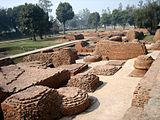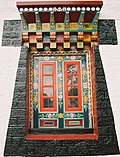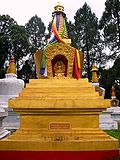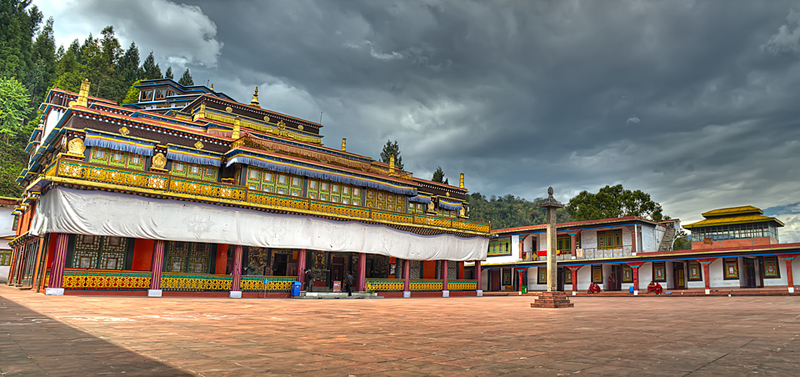In religion and spirituality, a pilgrimage is a long journey or search of great moral significance. Sometimes, it is a journey to a sacred place or to a shrine of importance to a person’s beliefs and faith. Members of every major religion participate in pilgrimages. A person who makes such a journey is called a pilgrim.
There are number of historical Buddhist pilgrimage sites in India.
Places associated with the life of Buddha
Primary sites
| Pilgrimage to |
| Buddha’s Holy Sites |
|---|
 |
| The Four Main Sites |
|
| Four Additional Sites |
|
| Other Sites |
|
| Later Sites |
|
Buddhism offers four major sites of pilgrimage: the Buddha’s birthplace at Lumbini, the site where he attained Enlightenment Bodh Gaya, where he first preached at Benaras, and where he achieved Parinirvana at Kusinagara. These are three of the four holiest sites in Buddhism; the fourth, Lumbini, the birthplace of the Buddha, is now in southern Nepal:
- Bodh Gaya in Bihar, the site of the enlightenment of Gautama Buddha under a tree and top site in the list of world heritage sites in India.
- Kesaria stupa is a Buddhist stupa in Kesariya, located at a distance of 110 kilometres (68 mi) from Patna, in the Champaran (east) district of Bihar, India. The first construction of the Stupa is dated to the 3rd century BCE. Kesariya Stupa has a circumference of almost 400 feet (120 m) and raises to a height of about 104 feet (32 m).
- Nalanda (Sanskrit: नालंंदा ISO: Nālandā, pronounced ) was a renowned Buddhist University in the ancient kingdom of Magadha (modern-day Bihar) in India.Buddhist texts describe it as a Mahavihara, a revered Buddhist monastery.
- Sarnath near Varanasi in Uttar Pradesh, the site of the first sermon (Dhammacakkappavattana Sutta), where Buddha taught about the Middle Way, the Four Noble Truths and Noble Eightfold Path.
- Kushinagar in Uttar Pradesh, the site of the Buddha’s parinirvana and home of many famous meditation & prayer offering sites in India.
-

Maha Bodhi Temple at Bodh Gaya
-

Dhamek Stupa, Sarnath
-

Ancient Buddhist Monastery at Sarnath
-

Parinirvana Stupa at Kushinagar
-

Remains of ancient stupas in Kushinagar

Places visited by Buddha for discourse
- Andhra Pradesh:
- Nagarjunakonda in Guntur district: Seat of Mahayana
- Thotlakonda and Bojjannakonda in Visakhapatnam
- Bihar: The name of Bihar is derived from vihara, meaning monastery, such was the association of the area with Buddhism. In addition to these sites which were visited by the Buddha, other sites in India have become notable:
- Patna, — Formerly known as Pataliputra, it was the seat of the Mauryan empire and a significant Buddhist centre
- Rajgir, Bihar — Formerly known as Rajagaha, it was the capital of Magadha, ruled by King Bimbisara, one of the most prominent monarchs and supporters during the lifetime of the Buddha
- Nalanda, Bihar — Site of an ancient Buddhist university, destroyed by Bakhtiyar Khalji during Islamic attacks
- Sravasti, Uttar Pradesh — Formerly known as Savatthi, it was the capital of Kosala, ruled by King Pasenadi, one of the most prominent monarchs and supporters during the lifetime of the Buddha
- Vaishali, Bihar — Seat of a republican state of the Lichchavis, prominent supporters of the Buddha. Site of the Second Buddhist Council
- Haryana: Sacred places in the order of travel by Buddha, where he gave several important discourses documented in the Pali texts. After visiting Mathura, he travelled along Grand Trunk Road in Haryana (also see Buddhist pilgrimage sites in Haryana).
- From Mathura in Uttar Pradesh, Buddha travelled along Grand Trunk Road in Haryana (also see Buddhist pilgrimage sites in Haryana).
- Kamashpura Aastha Pugdal Pagoda (Kumashpur) in Sonipat city, the place where Buddha gave Mahasatipatthana sutta),.
- Kurukshetra Stupa on the banks of sacred Brahma Sarovar in Kurukshetra city
- Topra between Kurukshetra and Yamunanagar, now has a large open air museum park housing several replica of Ashoka’s edicts including largest Ashoka Chakra in the world
- Srughna, now known as the Sugh Ancient Mound, on outskirts of Yamunanagar city
- Chaneti Stupa, on outskirts of Yamunanagar city
Other prominent historic Buddhist sites by state
All are the historic ancient sites of learning, and the list includes very few relatively new sites which have been specifically highlighted accordingly. Most of these sites have association with Ashoka and other Buddhist kings.
Andhra Pradesh
- Amaravati
- Bavikonda
- Bojjannakonda
- Bhattiprolu
- Chandavaram
- Dharanikota
- Ghantasala
- Gudivada
- Guntupalli
- Jaggayyapeta
- Nagarjunakonda
- Pavurallakonda museum
- Ramatheertham
- Salihundam
- Thotlakonda
- Undavalli Caves
- Visakhapatnam
Arunachal Pradesh
Please see Tibetan Buddhist section below, please do not add those to this list.
Assam
- Namphake in Dibrugarh
- Surya Pahar in Goalpara
- Hayagriva Madhava at Hajo
Bihar
- Vikramshila,
- Odantapuri
- Sujata Stupa
- Krimila
Goa
- Lamgao caves
- Rivona caves
Gujarat
- Vadnagar in Mehsana district
Haryana
In 2021, it was announced that Buddha Haryana circuit will be developed by the Centre
Also see above the “places visited by Buddha for discourse” which has additional sites in Haryana.
- Adi Badri, Haryana
- Mounds: Agroha Mound, Sugh Ancient Mound
- Pillars of Ashoka: (Hisar, Fatehabad Ashokan Pillar, Topra Kalan Edicts Museum)
Jammu and Kashmir
Please do not add Tibetan Buddhist sites to this list, add those to the “Tibetan Buddhist section” below.
- Harwan, near Mughal Shalimar Garden, dating from the fifth century
- Parihaspore, 20 km northeast of Srinagar
- Panderathan, near Srinagar
Madhya Pradesh
- Bagh Caves
- Sanchi, site of a large stupa built by Ashoka which also houses the relics of Sariputra and Mahamoggallana, the two chief disciples of the Buddha; reputedly the place from which Mahinda set out to proselytise Sri Lanka.
Maharashtra
- Ajanta, site of intricate Buddhist cave paintings depicting Buddhism
- Ellora, site of intricate Buddhist cave paintings
- Deekshabhoomi, a new 20th century site associated with Bhimrao Ambedkar
Odisha
- Lalitgiri
- Ratnagiri
- Udayagiri
Sikkim
Please see Tibetan Buddhist section below, please do not add those to this list.
Tamilnadu
|
This section is empty. You can help by adding to it. (December 2019)
|
Telangana
- Nelakondapalli,
- Phanigiri
Tripura
- Pilak, an archaeological site in the Santirbazar sub-division of South Tripura district
Uttar Pradesh
- Devadaha
- Kapilavastu
- Kosambi
- Mathura
- Pāvā (Fazilnagar near Varanasi
Tibetan Buddhist sites
By state
- Arunachal Pradesh: Tawang
- Sikkim: Dubdi Monastery, Enchey Monastery, Pemayangtse Monastery, Ralang Monastery, Rumtek, Tashiding Monastery, Tawang Monastery, Zang Dhok Palri Phodang
- Himachal Pradesh:
- Dharamsala,
- McLeod Ganj at Dharamsala, the primary seat of current Dalai Lama
- Palpung Sherabling Monastery at Baijnath
- Tabo Monastery, Spiti Valley, Himachal Pradesh
- Karnataka: Namdroling Monastery in Bylakuppe near Mysore
- Ladakh: Leh
Sikkim
Dubdi Monastery
Dubdi Monastery, occasionally called ‘Yuksom Monastery’ is a Buddhist monastery of the Nyingma sect of Tibetan Buddhism near Yuksom, in the Geyzing subdivision of West Sikkim district.
Enchey Monastery
Enchey Monastery is located in Gangtok, the capital city of Sikkim in the Northeastern Indian state. It belongs to the Nyingma order of Vajrayana Buddhism.
Pemayangtse Monastery
Pemayangtse Monastery is a Buddhist monastery in Pemayangtse, near Pelling in the northeastern Indian state of Sikkim, located 140 kilometres (87 mi) west of Gangtok.
Ralang Monastery
Ralang Monastery is a Buddhist monastery of the Kagyu sect of Tibetan Buddhism in southern Sikkim, northeastern India. It is located six kilometres from Ravangla.
Rumtek Monastery
Rumtek Monastery also called the “Dharmachakra Centre”, is a gompa located in the Indian state of Sikkim near the capital Gangtok. It is a focal point for the sectarian tensions within the Karma Kagyu school of Tibetan Buddhism that characterize the Karmapa controversy.
Tashiding Monastery
Tashiding Monastery is a Buddhist monastery of the Nyingma sect of Tibetan Buddhism in Western Sikkim, northeastern India. It is located on top of the hill rising between the Rathong chu and the Rangeet River.
Tawang Monastery
Tawang Monastery in the Indian state of Arunachal Pradesh is the largest monastery in India and second largest in the world after the Potala Palace in Lhasa, Tibet.
Zang Dhok Palri Phodang
Zang Dhok Palri Phodang is a Buddhist monastery in Kalimpong in West Bengal, India. The monastery is located atop Durpin Hill, one of the two hills of the town. It was consecrated in 1976 by the visiting Dalai Lama.
Gallery
-

The Manadala at the “Kakaling”, the entry gate to the Tawang Monastery.
-

Pemayangtse Monastery.
-

The Zang Dhok Palri Phodang monastery atop Durpin Hill.
-
Prayer Wheels in the Rumtek Monastery.
-

Ornately carved colourful Window of Enchey Monastery.
-

Dubdi Monastery.
-

The Golden Chorten near Tashiding Monastery.
-

Ralang Monastery.

Rumtek Monastery, Sikkim, India.

